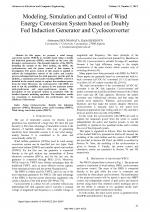| 2/2014 - 7 |
Modeling, Simulation and Control of Wind Energy Conversion System based on Doubly Fed Induction Generator and CycloconverterBOUMASSATA, A. |
| Extra paper information in |
| Click to see author's profile in |
| Download PDF |
Author keywords
cycloconverter, doubly fed induction generator, maximum power point tracking, wind energy conversion system
References keywords
power(30), wind(19), energy(19), control(18), systems(10), induction(9), doubly(9), generator(8), dfig(8), system(7)
Blue keywords are present in both the references section and the paper title.
About this article
Date of Publication: 2014-05-31
Volume 14, Issue 2, Year 2014, On page(s): 43 - 48
ISSN: 1582-7445, e-ISSN: 1844-7600
Digital Object Identifier: 10.4316/AECE.2014.02007
Web of Science Accession Number: 000340868100007
SCOPUS ID: 84901840378
Abstract
In this paper, we propose a wind energy conversion system (WECS) at variable speed using a doubly fed induction generator (DFIG) controlled on the rotor side through a cycloconverter. The dynamic behavior of the WECS, including the models of the wind turbine, the DFIG, the cycloconverter, and the power control of this system, is investigated. The power control of this system is applied to achieve the independent control of the active and reactive powers exchanged between the wind generator and the grid. In addition, a maximum power point tracking (MPPT) control is included in the control system to capture the maximum power from the wind. Moreover, the cycloconverter with DFIG are used to test the possibility to operate in two quadrant modes (sub-synchronous and super-synchronous modes). The description of the proposed system is presented with the detailed dynamic modeling equations. The simulation results are presented, to demonstrate the performance and the efficiency of this system. |
| References | | | Cited By |
Web of Science® Times Cited: 7 [View]
View record in Web of Science® [View]
View Related Records® [View]
Updated today
SCOPUS® Times Cited: 9
View record in SCOPUS® [Free preview]
View citations in SCOPUS® [Free preview]
[1] Speed control of a doubly fed induction machine via an AC–AC converter, Boumassata, Abderraouf, Kerdoun, Djallel, International Journal of System Assurance Engineering and Management, ISSN 0975-6809, Issue S1, Volume 8, 2017.
Digital Object Identifier: 10.1007/s13198-015-0361-7 [CrossRef]
[2] A Comprehensive Study of Harmonic Pollution in Large Penetrated Grid-Connected Wind Farm, Bhadane, Kishor V., Ballal, M. S., Nayyar, Anand, Patil, D. P., Jaware, T. H., Shukla, H. P., MAPAN, ISSN 0970-3950, Issue 4, Volume 36, 2021.
Digital Object Identifier: 10.1007/s12647-020-00407-z [CrossRef]
[3] Analysis of a Permanent Magnet Eddy Current Heater Driven by a Wind Turbine, TUDORACHE, T., MELCESCU, L., PREDESCU, M., Advances in Electrical and Computer Engineering, ISSN 1582-7445, Issue 3, Volume 15, 2015.
Digital Object Identifier: 10.4316/AECE.2015.03007 [CrossRef] [Full text]
[4] Modeling, Control, and Experimental Verification of a 500 kW DFIG Wind Turbine, AYKUT, O., ULU, C., KOMURGOZ, G., Advances in Electrical and Computer Engineering, ISSN 1582-7445, Issue 1, Volume 22, 2022.
Digital Object Identifier: 10.4316/AECE.2022.01002 [CrossRef] [Full text]
[5] Direct powers control of DFIG through direct converter and sliding mode control for WECS, Boumassata, Abderraouf, Kerdoun, Djallel, 2015 3rd International Conference on Control, Engineering & Information Technology (CEIT), ISBN 978-1-4799-8212-7, 2015.
Digital Object Identifier: 10.1109/CEIT.2015.7233058 [CrossRef]
[6] Grid power control based on a wind energy conversion system and a flywheel energy storage system, Boumassata, Abderraouf, Kerdoun, Djallel, Madaci, Mansour, IEEE EUROCON 2015 - International Conference on Computer as a Tool (EUROCON), ISBN 978-1-4799-8569-2, 2015.
Digital Object Identifier: 10.1109/EUROCON.2015.7313699 [CrossRef]
Disclaimer: All information displayed above was retrieved by using remote connections to respective databases. For the best user experience, we update all data by using background processes, and use caches in order to reduce the load on the servers we retrieve the information from. As we have no control on the availability of the database servers and sometimes the Internet connectivity may be affected, we do not guarantee the information is correct or complete. For the most accurate data, please always consult the database sites directly. Some external links require authentication or an institutional subscription.
Web of Science® is a registered trademark of Clarivate Analytics, Scopus® is a registered trademark of Elsevier B.V., other product names, company names, brand names, trademarks and logos are the property of their respective owners.
Faculty of Electrical Engineering and Computer Science
Stefan cel Mare University of Suceava, Romania
All rights reserved: Advances in Electrical and Computer Engineering is a registered trademark of the Stefan cel Mare University of Suceava. No part of this publication may be reproduced, stored in a retrieval system, photocopied, recorded or archived, without the written permission from the Editor. When authors submit their papers for publication, they agree that the copyright for their article be transferred to the Faculty of Electrical Engineering and Computer Science, Stefan cel Mare University of Suceava, Romania, if and only if the articles are accepted for publication. The copyright covers the exclusive rights to reproduce and distribute the article, including reprints and translations.
Permission for other use: The copyright owner's consent does not extend to copying for general distribution, for promotion, for creating new works, or for resale. Specific written permission must be obtained from the Editor for such copying. Direct linking to files hosted on this website is strictly prohibited.
Disclaimer: Whilst every effort is made by the publishers and editorial board to see that no inaccurate or misleading data, opinions or statements appear in this journal, they wish to make it clear that all information and opinions formulated in the articles, as well as linguistic accuracy, are the sole responsibility of the author.



